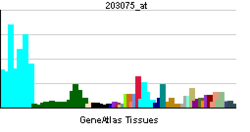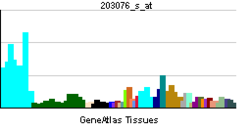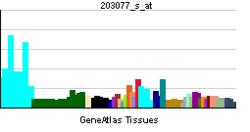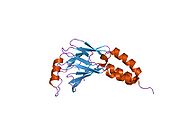- Mothers against decapentaplegic homolog 2
-
Mothers against decapentaplegic homolog 2 also known as SMAD family member 2 or SMAD2 is a protein that in humans is encoded by the SMAD2 gene.[1][2] MAD homolog 2 belongs to the SMAD, a family of proteins similar to the gene products of the Drosophila gene 'mothers against decapentaplegic' (Mad) and the C. elegans gene Sma. SMAD proteins are signal transducers and transcriptional modulators that mediate multiple signaling pathways.
Contents
Function
SMAD2 mediates the signal of the transforming growth factor (TGF)-beta, and thus regulates multiple cellular processes, such as cell proliferation, apoptosis, and differentiation. This protein is recruited to the TGF-beta receptors through its interaction with the SMAD anchor for receptor activation (SARA) protein. In response to TGF-beta signal, this protein is phosphorylated by the TGF-beta receptors. The phosphorylation induces the dissociation of this protein with SARA and the association with the family member SMAD4. The association with SMAD4 is important for the translocation of this protein into the cell nucleus, where it binds to target promoters and forms a transcription repressor complex with other cofactors. This protein can also be phosphorylated by activin type 1 receptor kinase, and mediates the signal from the activin. Alternatively spliced transcript variants encoding the same protein have been observed.[3]
Like other Smads, Smad2 plays a role in the transmission of extracellular signals from ligands of the Transforming Growth Factor beta (TGFβ) superfamily of growth factors into the cell nucleus. Binding of a subgroup of TGFβ superfamily ligands to extracellular receptors triggers phosphorylation of Smad2 at a Serine-Serine-Methionine-Serine (SSMS) motif at its extreme C-terminus. Phosphorylated Smad2 is then able to form a complex with Smad4. These complexes accumulate in the cell nucleus, where they are directly participating in the regulation of gene expression.
Nomenclature
The SMAD proteins are homologs of both the drosophila protein, mothers against decapentaplegic (MAD) and the C. elegans protein SMA. The name is a combination of the two. During Drosophila research, it was found that a mutation in the gene MAD in the mother repressed the gene decapentaplegic in the embryo. The phrase "Mothers against" was added, since mothers often form organizations opposing various issues, e.g., Mothers Against Drunk Driving, or (MADD). The nomenclature for this protein, like that of Sonic hedgehog, has been criticized for its frivolity[by whom?].
Interactions
Mothers against decapentaplegic homolog 2 has been shown to interact with:
References
- ^ Eppert K, Scherer SW, Ozcelik H, Pirone R, Hoodless P, Kim H, Tsui LC, Bapat B, Gallinger S, Andrulis IL, Thomsen GH, Wrana JL, Attisano L (August 1996). "MADR2 maps to 18q21 and encodes a TGFbeta-regulated MAD-related protein that is functionally mutated in colorectal carcinoma". Cell 86 (4): 543–52. doi:10.1016/S0092-8674(00)80128-2. PMID 8752209.
- ^ Riggins GJ, Thiagalingam S, Rozenblum E, Weinstein CL, Kern SE, Hamilton SR, Willson JK, Markowitz SD, Kinzler KW, Vogelstein B (July 1996). "Mad-related genes in the human". Nat. Genet. 13 (3): 347–9. doi:10.1038/ng0796-347. PMID 8673135.
- ^ "Entrez Gene: SMAD2 SMAD family member 2". http://www.ncbi.nlm.nih.gov/sites/entrez?Db=gene&Cmd=ShowDetailView&TermToSearch=4087.
- ^ Nourry, Claire; Maksumova Lola, Pang Mona, Liu Xiaohong, Wang Tongwen (May. 2004). "Direct interaction between Smad3, APC10, CDH1 and HEF1 in proteasomal degradation of HEF1". BMC Cell Biol. 5: 20. doi:10.1186/1471-2121-5-20. PMC 420458. PMID 15144564. http://www.pubmedcentral.nih.gov/articlerender.fcgi?tool=pmcentrez&artid=420458.
- ^ Hocevar, B A; Smine A, Xu X X, Howe P H (Jun. 2001). "The adaptor molecule Disabled-2 links the transforming growth factor β receptors to the Smad pathway". EMBO J. 20 (11): 2789–801. doi:10.1093/emboj/20.11.2789. ISSN 0261-4189. PMC 125498. PMID 11387212. http://www.pubmedcentral.nih.gov/articlerender.fcgi?tool=pmcentrez&artid=125498.
- ^ a b c d Wotton, D; Lo R S, Lee S, Massagué J (Apr. 1999). "A Smad transcriptional corepressor". Cell 97 (1): 29–39. doi:10.1016/S0092-8674(00)80712-6. ISSN 0092-8674. PMID 10199400.
- ^ a b Pessah, M; Prunier C, Marais J, Ferrand N, Mazars A, Lallemand F, Gauthier J M, Atfi A (May. 2001). "c-Jun interacts with the corepressor TG-interacting factor (TGIF) to suppress Smad2 transcriptional activity". Proc. Natl. Acad. Sci. U.S.A. 98 (11): 6198–203. doi:10.1073/pnas.101579798. ISSN 0027-8424. PMC 33445. PMID 11371641. http://www.pubmedcentral.nih.gov/articlerender.fcgi?tool=pmcentrez&artid=33445.
- ^ Liu, B; Dou C L, Prabhu L, Lai E (Jan. 1999). "FAST-2 Is a Mammalian Winged-Helix Protein Which Mediates Transforming Growth Factor β Signals". Mol. Cell. Biol. 19 (1): 424–30. ISSN 0270-7306. PMC 83900. PMID 9858566. http://www.pubmedcentral.nih.gov/articlerender.fcgi?tool=pmcentrez&artid=83900.
- ^ Liu, F; Pouponnot C, Massagué J (Dec. 1997). "Dual role of the Smad4/DPC4 tumor suppressor in TGFβ-inducible transcriptional complexes". Genes Dev. 11 (23): 3157–67. doi:10.1101/gad.11.23.3157. ISSN 0890-9369. PMC 316747. PMID 9389648. http://www.pubmedcentral.nih.gov/articlerender.fcgi?tool=pmcentrez&artid=316747.
- ^ Dou, C; Lee J, Liu B, Liu F, Massague J, Xuan S, Lai E (Sep. 2000). "BF-1 Interferes with Transforming Growth Factor β Signaling by Associating with Smad Partners". Mol. Cell. Biol. 20 (17): 6201–11. doi:10.1128/MCB.20.17.6201-6211.2000. ISSN 0270-7306. PMC 86095. PMID 10938097. http://www.pubmedcentral.nih.gov/articlerender.fcgi?tool=pmcentrez&artid=86095.
- ^ Chen, X; Weisberg E, Fridmacher V, Watanabe M, Naco G, Whitman M (Sep. 1997). "Smad4 and FAST-1 in the assembly of activin-responsive factor". Nature 389 (6646): 85–9. doi:10.1038/38008. ISSN 0028-0836. PMID 9288972.
- ^ O'Neill, T J; Zhu Y, Gustafson T A (Apr. 1997). "Interaction of MAD2 with the carboxyl terminus of the insulin receptor but not with the IGFIR. Evidence for release from the insulin receptor after activation". J. Biol. Chem. 272 (15): 10035–40. doi:10.1074/jbc.272.15.10035. ISSN 0021-9258. PMID 9092546.
- ^ Labbé, E; Letamendia A, Attisano L (Jul. 2000). "Association of Smads with lymphoid enhancer binding factor 1/T cell-specific factor mediates cooperative signaling by the transforming growth factor-β and Wnt pathways". Proc. Natl. Acad. Sci. U.S.A. 97 (15): 8358–63. doi:10.1073/pnas.150152697. ISSN 0027-8424. PMC 26952. PMID 10890911. http://www.pubmedcentral.nih.gov/articlerender.fcgi?tool=pmcentrez&artid=26952.
- ^ Feng, Xin-Hua; Liang Yao-Yun, Liang Min, Zhai Weiguo, Lin Xia (Jan. 2002). "Direct interaction of c-Myc with Smad2 and Smad3 to inhibit TGF-beta-mediated induction of the CDK inhibitor p15(Ink4B)". Mol. Cell 9 (1): 133–43. doi:10.1016/S1097-2765(01)00430-0. ISSN 1097-2765. PMID 11804592.
- ^ Quinn, Z A; Yang C C, Wrana J L, McDermott J C (Feb. 2001). "Smad proteins function as co-modulators for MEF2 transcriptional regulatory proteins". Nucleic Acids Res. 29 (3): 732–42. doi:10.1093/nar/29.3.732. PMC 30396. PMID 11160896. http://www.pubmedcentral.nih.gov/articlerender.fcgi?tool=pmcentrez&artid=30396.
- ^ Long, Jianyin; Wang Guannan, Matsuura Isao, He Dongming, Liu Fang (Jan. 2004). "Activation of Smad transcriptional activity by protein inhibitor of activated STAT3 (PIAS3)". Proc. Natl. Acad. Sci. U.S.A. 101 (1): 99–104. doi:10.1073/pnas.0307598100. ISSN 0027-8424. PMC 314145. PMID 14691252. http://www.pubmedcentral.nih.gov/articlerender.fcgi?tool=pmcentrez&artid=314145.
- ^ a b Nakano, Ayako; Koinuma Daizo, Miyazawa Keiji, Uchida Takafumi, Saitoh Masao, Kawabata Masahiro, Hanai Jun-ichi, Akiyama Hirotada, Abe Masahiro, Miyazono Kohei, Matsumoto Toshio, Imamura Takeshi (Mar. 2009). "Pin1 down-regulates transforming growth factor-beta (TGF-beta) signaling by inducing degradation of Smad proteins". J. Biol. Chem. 284 (10): 6109–15. doi:10.1074/jbc.M804659200. ISSN 0021-9258. PMID 19122240.
- ^ Harada, Jun; Kokura Kenji, Kanei-Ishii Chie, Nomura Teruaki, Khan Md Matiullah, Kim Yongsok, Ishii Shunsuke (Oct. 2003). "Requirement of the co-repressor homeodomain-interacting protein kinase 2 for ski-mediated inhibition of bone morphogenetic protein-induced transcriptional activation". J. Biol. Chem. 278 (40): 38998–9005. doi:10.1074/jbc.M307112200. ISSN 0021-9258. PMID 12874272.
- ^ Luo, K; Stroschein S L, Wang W, Chen D, Martens E, Zhou S, Zhou Q (Sep. 1999). "The Ski oncoprotein interacts with the Smad proteins to repress TGFβ signaling". Genes Dev. 13 (17): 2196–206. doi:10.1101/gad.13.17.2196. ISSN 0890-9369. PMC 316985. PMID 10485843. http://www.pubmedcentral.nih.gov/articlerender.fcgi?tool=pmcentrez&artid=316985.
- ^ Stroschein, S L; Bonni S, Wrana J L, Luo K (Nov. 2001). "Smad3 recruits the anaphase-promoting complex for ubiquitination and degradation of SnoN". Genes Dev. 15 (21): 2822–36. doi:10.1101/gad.912901. ISSN 0890-9369. PMC 312804. PMID 11691834. http://www.pubmedcentral.nih.gov/articlerender.fcgi?tool=pmcentrez&artid=312804.
- ^ Stroschein, S L; Wang W, Zhou S, Zhou Q, Luo K (Oct. 1999). "Negative feedback regulation of TGF-beta signaling by the SnoN oncoprotein". Science 286 (5440): 771–4. doi:10.1126/science.286.5440.771. ISSN 0036-8075. PMID 10531062.
- ^ Nakao, A; Imamura T, Souchelnytskyi S, Kawabata M, Ishisaki A, Oeda E, Tamaki K, Hanai J, Heldin C H, Miyazono K, ten Dijke P (Sep. 1997). "TGF-beta receptor-mediated signalling through Smad2, Smad3 and Smad4". EMBO J. 16 (17): 5353–62. doi:10.1093/emboj/16.17.5353. ISSN 0261-4189. PMC 1170167. PMID 9311995. http://www.pubmedcentral.nih.gov/articlerender.fcgi?tool=pmcentrez&artid=1170167.
- ^ Lebrun, J J; Takabe K, Chen Y, Vale W (Jan. 1999). "Roles of pathway-specific and inhibitory Smads in activin receptor signaling". Mol. Endocrinol. 13 (1): 15–23. doi:10.1210/me.13.1.15. ISSN 0888-8809. PMID 9892009.
- ^ Lin, X; Liang M, Feng X H (Nov. 2000). "Smurf2 is a ubiquitin E3 ligase mediating proteasome-dependent degradation of Smad2 in transforming growth factor-beta signaling". J. Biol. Chem. 275 (47): 36818–22. doi:10.1074/jbc.C000580200. ISSN 0021-9258. PMID 11016919.
- ^ Bonni, S; Wang H R, Causing C G, Kavsak P, Stroschein S L, Luo K, Wrana J L (Jun. 2001). "TGF-beta induces assembly of a Smad2-Smurf2 ubiquitin ligase complex that targets SnoN for degradation". Nat. Cell Biol. 3 (6): 587–95. doi:10.1038/35078562. ISSN 1465-7392. PMID 11389444.
- ^ Leong, G M; Subramaniam N, Figueroa J, Flanagan J L, Hayman M J, Eisman J A, Kouzmenko A P (May. 2001). "Ski-interacting protein interacts with Smad proteins to augment transforming growth factor-beta-dependent transcription". J. Biol. Chem. 276 (21): 18243–8. doi:10.1074/jbc.M010815200. ISSN 0021-9258. PMID 11278756.
- ^ Datta, P K; Moses H L (May. 2000). "STRAP and Smad7 Synergize in the Inhibition of Transforming Growth Factor β Signaling". Mol. Cell. Biol. 20 (9): 3157–67. doi:10.1128/MCB.20.9.3157-3167.2000. ISSN 0270-7306. PMC 85610. PMID 10757800. http://www.pubmedcentral.nih.gov/articlerender.fcgi?tool=pmcentrez&artid=85610.
Further reading
- Wrana JL (1998). "TGF-beta receptors and signalling mechanisms". Mineral and electrolyte metabolism 24 (2–3): 120–30. doi:10.1159/000057359. PMID 9525694.
- Massagué J (1998). "TGF-beta signal transduction". Annu. Rev. Biochem. 67: 753–91. doi:10.1146/annurev.biochem.67.1.753. PMID 9759503.
- Verschueren K, Huylebroeck D (2000). "Remarkable versatility of Smad proteins in the nucleus of transforming growth factor-beta activated cells". Cytokine Growth Factor Rev. 10 (3–4): 187–99. doi:10.1016/S1359-6101(99)00012-X. PMID 10647776.
- Wrana JL, Attisano L (2000). "The Smad pathway". Cytokine Growth Factor Rev. 11 (1–2): 5–13. doi:10.1016/S1359-6101(99)00024-6. PMID 10708948.
- Miyazono K (2000). "TGF-beta signaling by Smad proteins". Cytokine Growth Factor Rev. 11 (1–2): 15–22. doi:10.1016/S1359-6101(99)00025-8. PMID 10708949.
- Zannis VI, Kan HY, Kritis A et al. (2001). "Transcriptional regulation of the human apolipoprotein genes". Front. Biosci. 6: D456–504. doi:10.2741/Zannis. PMID 11229886.
PDB gallery 1dev: CRYSTAL STRUCTURE OF SMAD2 MH2 DOMAIN BOUND TO THE SMAD-BINDING DOMAIN OF SARA1khx: Crystal structure of a phosphorylated Smad21mjs: MH2 domain of transcriptional factor SMAD31mk2: SMAD3 SBD complex1u7f: Crystal Structure of the phosphorylated Smad3/Smad4 heterotrimeric complex1u7v: Crystal Structure of the phosphorylated Smad2/Smad4 heterotrimeric complexCell signaling: TGF beta signaling pathway TGF beta superfamily of ligands TGF beta family (TGF-β1, TGF-β2, TGF-β3)
Bone morphogenetic proteins (BMP2, BMP3, BMP4, BMP5, BMP6, BMP7, BMP8a, BMP8b, BMP10 , BMP15)
Growth differentiation factors (GDF1, GDF2, GDF3, GDF5, GDF6, GDF7, Myostatin/GDF8, GDF9, GDF10, GDF11, GDF15)
Other (Activin and inhibin, Anti-müllerian hormone, Nodal)TGF beta receptors
(Activin, BMP)TGFBR1: Activin type 1 receptors (ACVR1, ACVR1B, ACVR1C) · ACVRL1 · BMPR1 (BMPR1A · BMPR1B)
TGFBR2: Activin type 2 receptors (ACVR2A, ACVR2B) · AMHR2 · BMPR2
TGFBR3: betaglycanTransducers/SMAD Ligand inhibitors Coreceptors Other SARAB trdu: iter (nrpl/grfl/cytl/horl), csrc (lgic, enzr, gprc, igsr, intg, nrpr/grfr/cytr), itra (adap, gbpr, mapk), calc, lipd; path (hedp, wntp, tgfp+mapp, notp, jakp, fsap, hipp, tlrp) Transcription factors and intracellular receptors (1) Basic domains (1.1) Basic leucine zipper (bZIP)Activating transcription factor (AATF, 1, 2, 3, 4, 5, 6, 7) · AP-1 (c-Fos, FOSB, FOSL1, FOSL2, JDP2, c-Jun, JUNB, JUND) · BACH (1, 2) · BATF · BLZF1 · C/EBP (α, β, γ, δ, ε, ζ) · CREB (1, 3, L1) · CREM · DBP · DDIT3 · GABPA · HLF · MAF (B, F, G, K) · NFE (2, L1, L2, L3) · NFIL3 · NRL · NRF (1, 2, 3) · XBP1(1.2) Basic helix-loop-helix (bHLH)ATOH1 · AhR · AHRR · ARNT · ASCL1 · BHLHB2 · BMAL (ARNTL, ARNTL2) · CLOCK · EPAS1 · FIGLA · HAND (1, 2) · HES (5, 6) · HEY (1, 2, L) · HES1 · HIF (1A, 3A) · ID (1, 2, 3, 4) · LYL1 · MESP2 · MXD4 · MYCL1 · MYCN · Myogenic regulatory factors (MyoD, Myogenin, MYF5, MYF6) · Neurogenins (1, 2, 3) · NeuroD (1, 2) · NPAS (1, 2, 3) · OLIG (1, 2) · Pho4 · Scleraxis · SIM (1, 2) · TAL (1, 2) · Twist · USF1(1.3) bHLH-ZIP(1.4) NF-1(1.5) RF-X(1.6) Basic helix-span-helix (bHSH)(2) Zinc finger DNA-binding domains (2.1) Nuclear receptor (Cys4)subfamily 1 (Thyroid hormone (α, β), CAR, FXR, LXR (α, β), PPAR (α, β/δ, γ), PXR, RAR (α, β, γ), ROR (α, β, γ), Rev-ErbA (α, β), VDR)
subfamily 2 (COUP-TF (I, II), Ear-2, HNF4 (α, γ), PNR, RXR (α, β, γ), Testicular receptor (2, 4), TLX)
subfamily 3 (Steroid hormone (Androgen, Estrogen (α, β), Glucocorticoid, Mineralocorticoid, Progesterone), Estrogen related (α, β, γ))
subfamily 4 NUR (NGFIB, NOR1, NURR1) · subfamily 5 (LRH-1, SF1) · subfamily 6 (GCNF) · subfamily 0 (DAX1, SHP)(2.2) Other Cys4(2.3) Cys2His2General transcription factors (TFIIA, TFIIB, TFIID, TFIIE (1, 2), TFIIF (1, 2), TFIIH (1, 2, 4, 2I, 3A, 3C1, 3C2))
ATBF1 · BCL (6, 11A, 11B) · CTCF · E4F1 · EGR (1, 2, 3, 4) · ERV3 · GFI1 · GLI-Krüppel family (1, 2, 3, REST, S2, YY1) · HIC (1, 2) · HIVEP (1, 2, 3) · IKZF (1, 2, 3) · ILF (2, 3) · KLF (2, 3, 4, 5, 6, 7, 8, 9, 10, 11, 12, 13, 14, 15, 17) · MTF1 · MYT1 · OSR1 · PRDM9 · SALL (1, 2, 3, 4) · SP (1, 2, 4, 7, 8) · TSHZ3 · WT1 · Zbtb7 (7A, 7B) · ZBTB (16, 17, 20, 32, 33, 40) · zinc finger (3, 7, 9, 10, 19, 22, 24, 33B, 34, 35, 41, 43, 44, 51, 74, 143, 146, 148, 165, 202, 217, 219, 238, 239, 259, 267, 268, 281, 295, 300, 318, 330, 346, 350, 365, 366, 384, 423, 451, 452, 471, 593, 638, 644, 649, 655)(2.4) Cys6(2.5) Alternating composition(3) Helix-turn-helix domains (3.1) HomeodomainARX · CDX (1, 2) · CRX · CUTL1 · DBX (1, 2) · DLX (3, 4, 5) · EMX2 · EN (1, 2) · FHL (1, 2, 3) · HESX1 · HHEX · HLX · Homeobox (A1, A2, A3, A4, A5, A7, A9, A10, A11, A13, B1, B2, B3, B4, B5, B6, B7, B8, B9, B13, C4, C5, C6, C8, C9, C10, C11, C13, D1, D3, D4, D8, D9, D10, D11, D12, D13) · HOPX · IRX (1, 2, 3, 4, 5, 6, MKX) · LMX (1A, 1B) · MEIS (1, 2) · MEOX2 · MNX1 · MSX (1, 2) · NANOG · NKX (2-1, 2-2, 2-3, 2-5, 3-1, 3-2, 6-1, 6-2) · NOBOX · PBX (1, 2, 3) · PHF (1, 3, 6, 8, 10, 16, 17, 20, 21A) · PHOX (2A, 2B) · PITX (1, 2, 3) · POU domain (PIT-1, BRN-3: A, B, C, Octamer transcription factor: 1, 2, 3/4, 6, 7, 11) · OTX (1, 2) · PDX1 · SATB2 · SHOX2 · VAX1 · ZEB (1, 2)(3.2) Paired box(3.3) Fork head / winged helix(3.4) Heat Shock Factors(3.5) Tryptophan clusters(3.6) TEA domain(4) β-Scaffold factors with minor groove contacts (4.1) Rel homology region(4.2) STAT(4.3) p53(4.4) MADS box(4.6) TATA binding proteins(4.7) High-mobility group(4.10) Cold-shock domainCSDA, YBX1(4.11) Runt(0) Other transcription factors (0.2) HMGI(Y)(0.3) Pocket domain(0.6) Miscellaneoussee also transcription factor/coregulator deficiencies
B bsyn: dna (repl, cycl, reco, repr) · tscr (fact, tcrg, nucl, rnat, rept, ptts) · tltn (risu, pttl, nexn) · dnab, rnab/runp · stru (domn, 1°, 2°, 3°, 4°)Neoplasm: Tumor suppressor genes/proteins and Oncogenes/Proto-oncogenes Ligand Receptor TSP: CDH1TSP: PTCH1TSP: TGF beta receptor 2Intracellular signaling P+Ps ONCO: Beta-catenin · TSP: APCTSP: SMAD2, SMAD4Hippo signaling pathwayOther/unknownNucleus TSP: VHL · ONCO: CBL - MDM2Mitochondria Other/ungrouped M: NEO
tsoc, mrkr
tumr, epon, para
drug (L1i/1e/V03)
This article incorporates text from the United States National Library of Medicine, which is in the public domain.
Categories:- Human proteins
- Developmental genes and proteins
- MH1 domain
- MH2 domain
- R-SMAD
- Transcription factors
Wikimedia Foundation. 2010.










